The Collector’s Edition Box project was born of the desire to shake up ways of looking at contemporary art, its modes of distribution, and the art market through the edition of a very affordable artwork. The project can be said to continue the very special narrative that The Laughing Cow® has maintained with contemporary artists since its inception, while respecting the values of sharing, excellence and innovation promoted by the Bel Group, with which it is associated. Between now and the 100th anniversary of the brand in 2021, this project will be repeated on an annual basis.
Since 2014, four artists have successfully participated in the exercise of confronting and integrating the brand and its codes, and all that it has managed to build over time with their own particular practice, and in so doing, shifting its perception. They skillfully responded to the commission from the Group and its Artistic Laboratory by questioning its status and the iconic character of its laughing effigy. The first artist commissioned, Hans-Peter Feldmann, accentuated the cow’s facetious dimension and pointed to the very essence of its identity. The second, Thomas Bayrle, used the cow as the constitutive motif of a larger graphic background in an effort to highlight its uniqueness, popularity and integration into our society, doubly pointing to its origins and international expansion. The third artist, Jonathan Monk, shifted the conceptual aspect of his deconstructed composition by transforming it into an exceptional object. The fourth artist, Wim Delvoye, took his inspiration from the brand’s promotional history, thereby becoming a part of it. Some of the invited artists had already developed a very close bond with the cow and had previously introduced it in their artwork (Thomas Bayrle, Wim Delvoye), either occasionally or in a more substantial corpus of works spread over time; others took advantage of this commission to extend the image of the cow through other proposals (Hans-Peter Feldmann and Jonathan Monk), thereby emphasizing a form of coherence between their approach and what they had been asked to do. There were even some artists who, need we recall, served their own collectors’ interests by diverting the history of the brand in a very personal incursion that was not without serving their own glory (Wim Delvoye) — but is it not this project’s very peculiarity to generate this type of temptation?
dizzying directions exploring the new perspectives that these opened, and drawing on the emulation generated by their inclusion in a series so brilliantly executed by their predecessors. They all took to heart the challenge with which they were entrusted, becoming part of the history of a brand which, despite its historical roots in a form of tradition, has underlined its timeless nature and an undeniable form of contemporaneity through this type of project. I can say with some degree of confidence that the Group, its employees and directors, but also the family that has been at its head for five generations, and of which I have the honor of being a member, are extremely grateful to these artists. Furthermore, we take great pride in these successive collaborations. I allow myself, on their behalf, to extend our warmest thanks.
The project has now found its audience. Welcomed since 2016 by the FIAC, the International Art Fair in Paris, in the prestigious setting of the Grand Palais, at the invitation of its director Jennifer Flay, it has quickly established itself as a highly anticipated event coveted by contemporary art amateurs and lovers of the brand. The box has stimulated the public’s collecting tendencies and has found its place in the homes of the most demanding of collectors, both individual and institutional. It is displayed on kitchen tables and bookshelves, just as it is stored away from light and moisture in the most secret of warehouses, while banking on the surpassing of its expiration date. For example, the first editions, no longer available, are now very sought after and speculation is high, following market-like logic.
Initially available in some supermarkets, for the most part in France but also abroad, the Collector’s Edition Box has been distributed via the Internet since 2017, which has increased its audience. The conclusion is indisputable: the brand has clearly become a valuable ambassador of its authors, contributing to giving contemporary art a more accessible and reassuring image, and developing an awareness of conceptual practices sometimes unknown to the general public. What very quickly emerged in the company as an object of pride and a constituent element of its culture, is today presented internationally as a case study used to explain to business and marketing students the extra meaning that a brand needs to bring to its consumers if it intends to distinguish itself from others, an action that has contributed to the success of The Laughing Cow® since the ‘20s. This recognition is equally strong in the contemporary art world where, edition after edition, the relevance of the various proposals has been demonstrated. The project has also revealed the possible relationships that could exist between art and business.
Today, the Bel and Lab’Bel teams are thrilled to continue this project by unveiling the fifth Collector’s Edition Box. They have entrusted its design to German conceptual artist Karin Sander, an artist whose approach they particularly admire. Michael Staab, the commissioner and linchpin of the project remains the curator of this fifth edition. Let us wager that Sander’s proposal, at once playful and impertinent, will surprise and entertain, and hopefully find its place in many homes. Bon appétit and happy collecting!
Laurent Fiévet
Director of Lab’Bel, The Artistic Laboratory of the Bel Group
